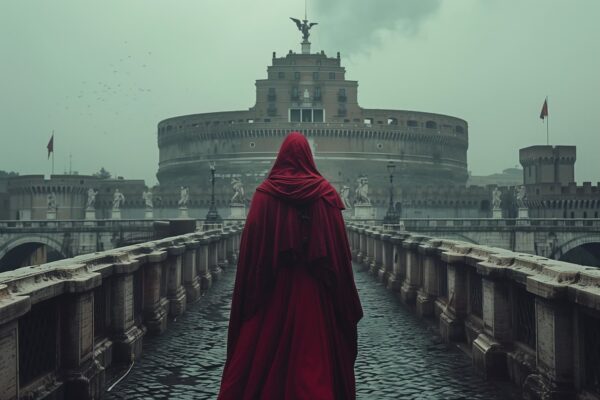If you are curious about the history of Castel Sant’Angelo, then you have come to the right place. With this post I will try to satisfy your thirst for knowledge, reconstructing with you the history of this important monument, from its ancient origins to the present day.
We will start with its history in brief and then delve deeper, where curiosities and mysteries abound.
Together we will discover the first nucleus of the mausoleum of Hadrian, its evolution into the Castle, descend into the darkness of its prisons and rise up to the Statue of the Angel, always mindful of the description of historical reality as well as the legends to which it is inextricably linked;
Are you ready to follow me on this journey? Then let’s go!
IMPORTANT! Before starting this article, I want to warn you: Castel Sant’Angelo is one of the most visited tourist attractions in Italy and the world. With a year-round tourist season, it is almost certain that when you want to visit it, you will find a long queue at the ticket office. To avoid this, we recommend that you buy your ticket online. Click below to book your entry and access Castel Sant’Angelo in an instant.
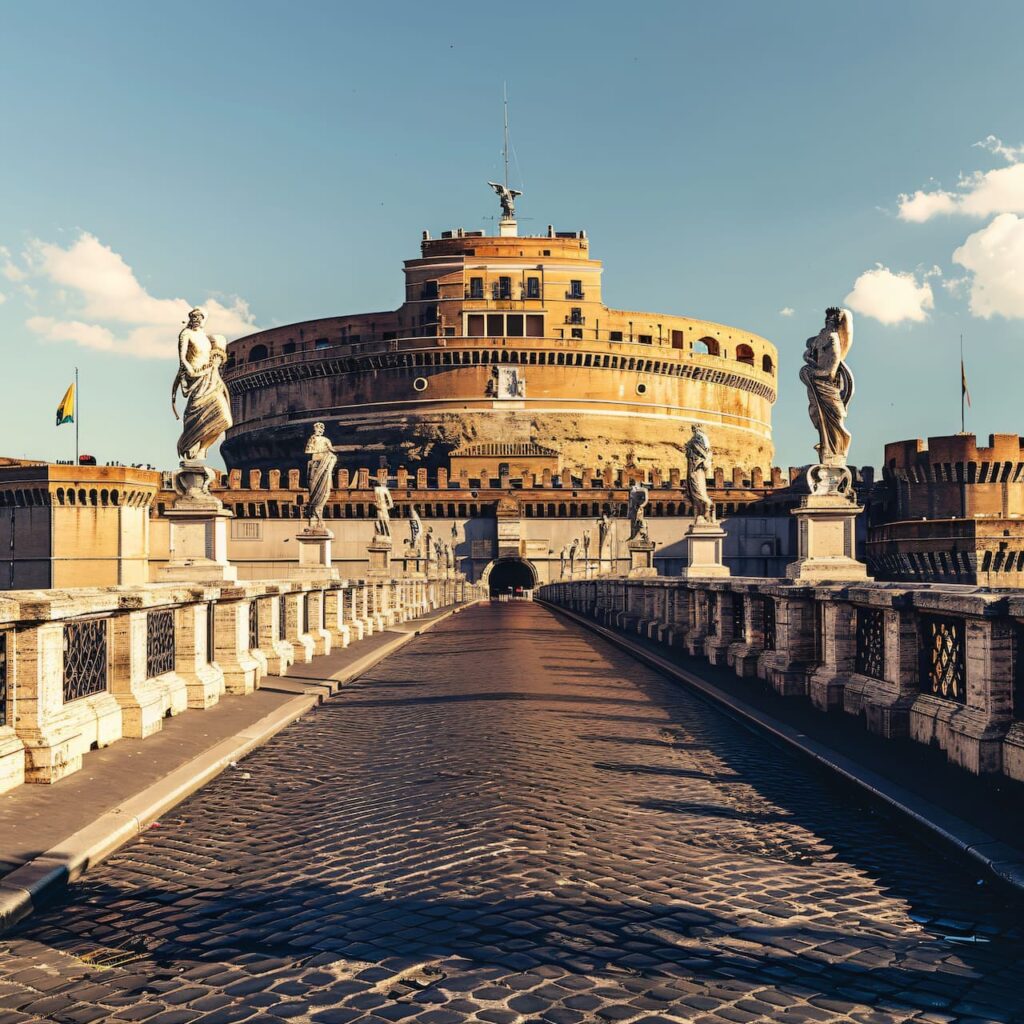
Tickets for Castel Sant’Angelo Rome: quick access
Buy online. Choose your preferred time. Visit Rome’s Castel Sant’Angelo, the Sant’Angelo Bridge, the prisons and much more.
You can cancel free of charge up to the day before the visit.
Contents
Castel Sant’Angelo Rome: description
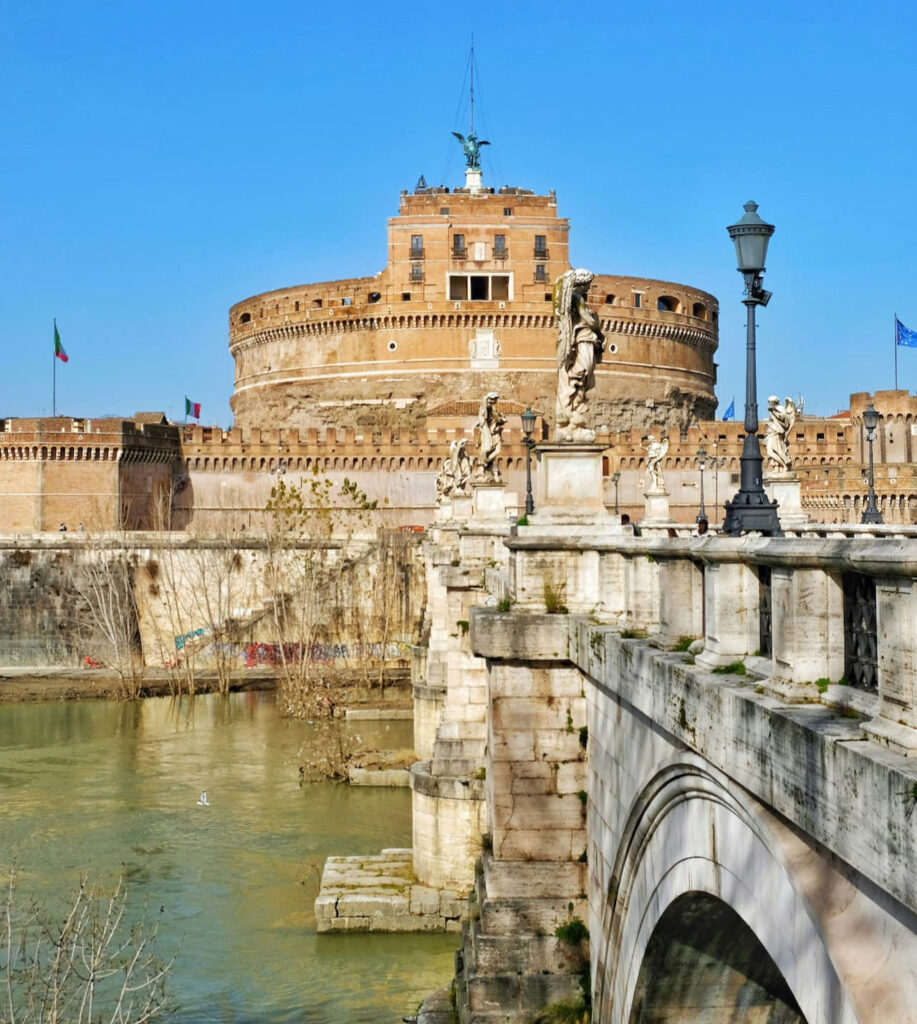
Castel Sant’Angelo, known in antiquity as the Mole Adrianorum and Castellum Crescentii, and still today as the mausoleum of Hadrian, is one of Rome’s main monuments.
It is located on the right bank of the Tiber River, opposite the Campus Martius, to which it is connected by the Sant’Angelo bridge, and a short distance from the State of the Vatican, reached through a fortified corridor known as the Passetto di Borgo.
Situated between the Borgo and Prati districts, the monument has a history stretching back thousands of years and has been modified and modernised several times from its foundation (123-135 A.D.) to the medieval age, to the Renaissance and to the present day.
Famous for being the tomb of Emperor Hadrian, the castle is also known to have served, throughout history, as a fortress, tribunal and prison of the Papal States.
Now state property of the Italian State, the castle is currently managed by the Direzione Musei statali di Roma and attracts millions of onlookers from all over the world every year.
Brief history of Castel Sant’Angelo Rome
The history of Castel Sant’Angelo is intrinsically linked to that of Rome. Born as the sepolcro of the Emperor Hadrian, it was finished by Antoninus Pius in 139 AD and fulfilled its original function for hundreds of years.
In about 403 A.D., the Western Emperor Onorio had it included in the Aurlian Walls: from this moment on, the funerary monument became a defence bulwark, losing its commemorative value and assuming a strategic one to protect the Eternal City.
It is precisely on this occasion that it first earned the name castellum, but it was not until 590 AD that, according to the legend that I tell you about here (insert link to the section Legends of Castel Sant’Angelo: the story of the Angel), it found its current name.
Many Roman families fought for possession of the castle. In the first half of the Xth century it was the stronghold of the senator Teofilatto, in the second half it was for the Crescenzi, who fortified it and gave it their name, then it passed to the Pierleoni family, and afterwards to the Orsini, to whom it was in all probability ceded by Pope Niccolò III, a member of the same family, after he had the Passetto di Borgo built, connecting the castle to the Vatican.
In 1367 it was Pope Urban V who was given the keys: from this moment on, the structure would serve as a refuge for the popes to come, would house the Archive and the Vatican Treasury, and would be a tribunal and prison.
In 1379 it was almost rebuilt to the ground, and in 1395 it was rebuilt and powered by the military architect Niccolò Lamberti by order of Pope Bonifacio IX. For four centuries, interventions followed one another, new structures were added and existing ones renovated.
After the Unification of Italy it will initially be used as a caserne, then become a museum. It will be restored by the Genius of the Regio Esercito and will house the Museum of Military Engineering. During the Ventennium, the bastions and ditches will be restored and several halls will be arranged.
Today, the National Museum of Castel Sant’Angelo houses numerous collections of ceramics, paintings and sculptures, and is the centre of courses, initiatives and educational activities that promote awareness of the Museum among the general public.
Castel Sant’Angelo Rome: In-Depth History
Roman origins

Adriano and Demetriano
Between 123 A.D. and 135 A.D.the Emperor Hadrian asked the architect Demeterianus to build a funeral mausoleum for himself and his family on the outskirts of Rome, in the area known as ager Vaticanus. The inspiration is clear from the model of the Augusteum, the mausoleum of Emperor Augustus, but Hadrian wants more: he wants a gigantic one.
In 139 A.D. the mausoleum was ready; it stood opposite the Campus Martius, to which it was joined by the Pons Aelio (Helios Bridge), today known as the Ponte di Sant’Angelo.
The forms are simple and clean: on the cubic base, made of Carrara marble, rises a tamburo made of peperino, a magmatic rock typical of Lazio, and opus caementicium (cement work); Above it rises the tumulus of earth, planted with trees and surrounded by marble statues, including the famous Fauno Berberini (also known as the Drunken Satyr).
At the corners of the plinth we find bronze statues of men and horses, and at the top a bronze panel led according to some by the god Helios, according to others by the emperor himself. Also characteristic is the decorative frieze with ox heads on which, on the side facing the Tiber, are the names of the emperors resting inside the building.
On the same side is the entrance arch, named after Hadrian, entirely clad in marmor numidicum, the ancient yellow marble. Around the mausoleum runs a wall with bronze wall and gilded bronze decorations.
Of this structure, which is almost unrecognisable today, many remains survive, such as the foundations of the basement, the masonry core of the drum, the monumental entrance and the helical ramp leading to the burial chamber: the Urna Room.
For hundreds of years, the mausoleum housed the remains of the Antonini: in addition to the remains of Adrian himself, who died a year before the work was completed, and of his wife Vibia Sabina, it housed those of Antoninus Pius, his wife Annia Galeria Faustina and their children; of Lucio Elio Caesar, of Commodus, of Marco Aurelio and three of his sons, of the emperor Settimio Severo, of his wife Giulia Domna and sons Geta and Caracalla.
The Middle Ages and The Renaissance
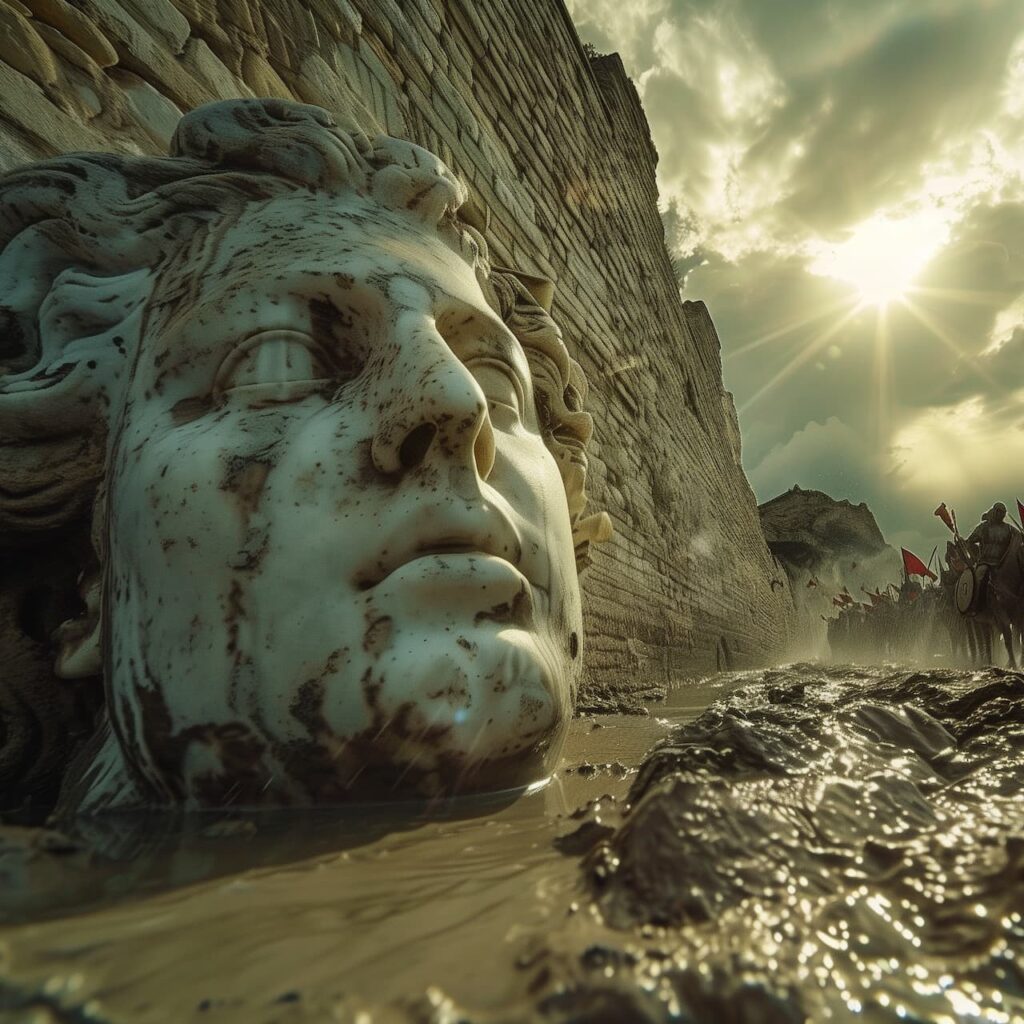
Statue of Bacchus hurled at enemies
In about 403 AD, the Mole Adriana was included in the Aurlian Walls. From then on, it was no longer just a funerary monument, but an important strategic point for the defence of the city. The fortified outpost beyond the Tiber thus earned the nickname castellum, and revealed all its importance during the sack of Rome first by the Visigoths of Alaric (410 AD), and then by the Vandals of Genseric (455 AD).
In the pits of the Castle, the statue of the Drunken Satyr, or Faunus Barberini, which we appreciate today among the best-preserved artefacts, but which was probably used by the Romans as a weapon of defence and hurled against invaders, was found.
At the dawn of the 6th century, the castellum took on a new function: it was used as a state prison at the behest of the Ostrogothic ruler Flavius Theodoric. It was also used as a prison by the Roman senator and military man Theophylact in the first half of the Xth century, as well as by his family: his daughter Maria, known as Marozia, and his grandson Albericus.
In the second half of the century, however, the fortress passed to the baronial family of the Crescenzi, who undertook to strengthen it for a century.
It is no coincidence that from this period onwards the castle is known by the name of Castrum Crescentii, and for a long time was so designated, even when it passed into the ownership of the noble family of Jewish origin of the Pierleoni, and later to that of the Orsini, famous for having given the Church many popes and cardinals, and who probably obtained it from Pope Niccolò III, born Giovanni Gaetano Orsini.
We also owe to Nicholas III the construction of the Passetto di Borgo, which constituted, for him and the popes to come, a protected passageway from the basilica of St. Peter’s to Castel Sant’Angelo.
The building remained in the ownership of the Orsini family until around 1365, when it was ceded to the Church, which, in 1367, handed over the keys to the Benedictine pontiff Urban V with the intention of urging its return to Rome and thus decreeing the end of the Avignonese activity.
In 1379 a popular uprising threatens to destroy the castle. In the midst of the Western Schism, Pope Boniface IX commissioned, in 1395, the military architect Niccolò Lamberti not only to rebuild, but also to undertake numerous improvements to the castle’s defensive layout.
Entrance to it thus becomes possible from a single ramp, protected by a drawbridge. In fact, Boniface IX opened a period of modernisation that ran through the next four centuries.
Towards the middle of the XV century, at the behest of Pope Niccolò V, the castle obtained its first papal residence and three bastions at the corners of the outer quadrilateral;
Modern Age

Banquets in the papal residences in Castello
Alexander VI Borgia, pope from 1492, commissioned the architect Antonio Giamberti da Sangallo, known as the Elder, to carry out major fortification work on the castle.
Applying the techniques of modern fortification, the architect transformed the castle into an authentic military stronghold with four new bastions. Again at the instigation of Alexander VI, a torrione was then built at the mouth of the bridge and a ditch was dug around the walls.
In addition, the castle is equipped with a new apartment, frescoed by none other than Pinturicchio, and new gardens and fountains.
What was once a mausoleum and then a fortress is now a luxurious palace in which the pontiff holds parties and banquets.
Even his successor, Julius II, preferred to reside inside the castle rather than in the Vatican Palace.
At his behest, Giuliano da Sangallo and Guglielmo da Monferrato improved the comfort of the papal lodgings, and built the Loggia verso il Tevere, still remembered today as Julius II.
But, beyond the pomp, the many works on the defensive structure were not in vain, as witnessed by the seven months of seizure that, a little over thirty years later, saw Pope Clemente VII resist the fearsome troops of Carlo V of Habsburg, the famous Lanzichenecchi, who in 1527 were the protagonists of the sack of Rome.
In 1542, it was Paul III who commissioned Antonio da Sangallo il Giovane to rebuild the castle; the decoration was entrusted to Perin del Vaga, a collaborator of Raphael, to Luzio Luzi and Livio Agresti, known as Il Riccioluto, among the leading exponents of Mannerism.
Paul IV, shortly after the middle of the century, instead ordered the construction of the pentagonal bastion wall surrounding the castle under the supervision of the architect Francesco Leparelli, famous for having been Michelangelo’s assistant and engineer to Cosimo I de’ Medici.
In 1630 Pope Urban VIII ordered the destruction of the previous fortifications, including the keep built by Alexander VI Borgia, and relocates the main entrance to the right side, as well as ordering the construction of a new curtain wall frontal walls, new guard posts and casermettes.
A little less than forty years later, Clemente IX devoted himself instead to Ponte Elio and ordered the installation of ten marble angels. From that very moment, the bridge would be named Ponte Sant’Angelo.
Contemporary Age
During the Eighteenth century, the castle, also called Forte Sant’Angelo, was used as a political prison.
It was only after the Unification of Italy that it became state property and was first converted into a caserne and then, following the Genio restoration work of the Regio Esercito, used as a museum.
The Marquis and Colonel Luigi Durand de la Penne, with his collaborator Mariano Borgatti, directed the work. Borgatti himself was the first director of the nascent Museo dell’ingegneria militare (Museum of Military Engineering), which was inaugurated inside the castle in February 1906. Five years later the museum was transferred to the ‘casermette’ built by Urban VIII.
In the Ventennio, between 1933 and 1934, a new wave of restoration ensured that the moats and ramparts were restored. The ‘barracks’ were demolished and the area between the square wall and the pentagonal structure was laid out as a garden. In 1939 the Museum of Military Engineering was definitively moved to another location.

Tickets for Castel Sant’Angelo Rome: quick access
Buy online. Choose your preferred time. Visit Rome’s Castel Sant’Angelo, the Sant’Angelo Bridge, the prisons and much more.
You can cancel free of charge up to the day before the visit.
Legends of Castel Sant’Angelo
The Story of the Angel
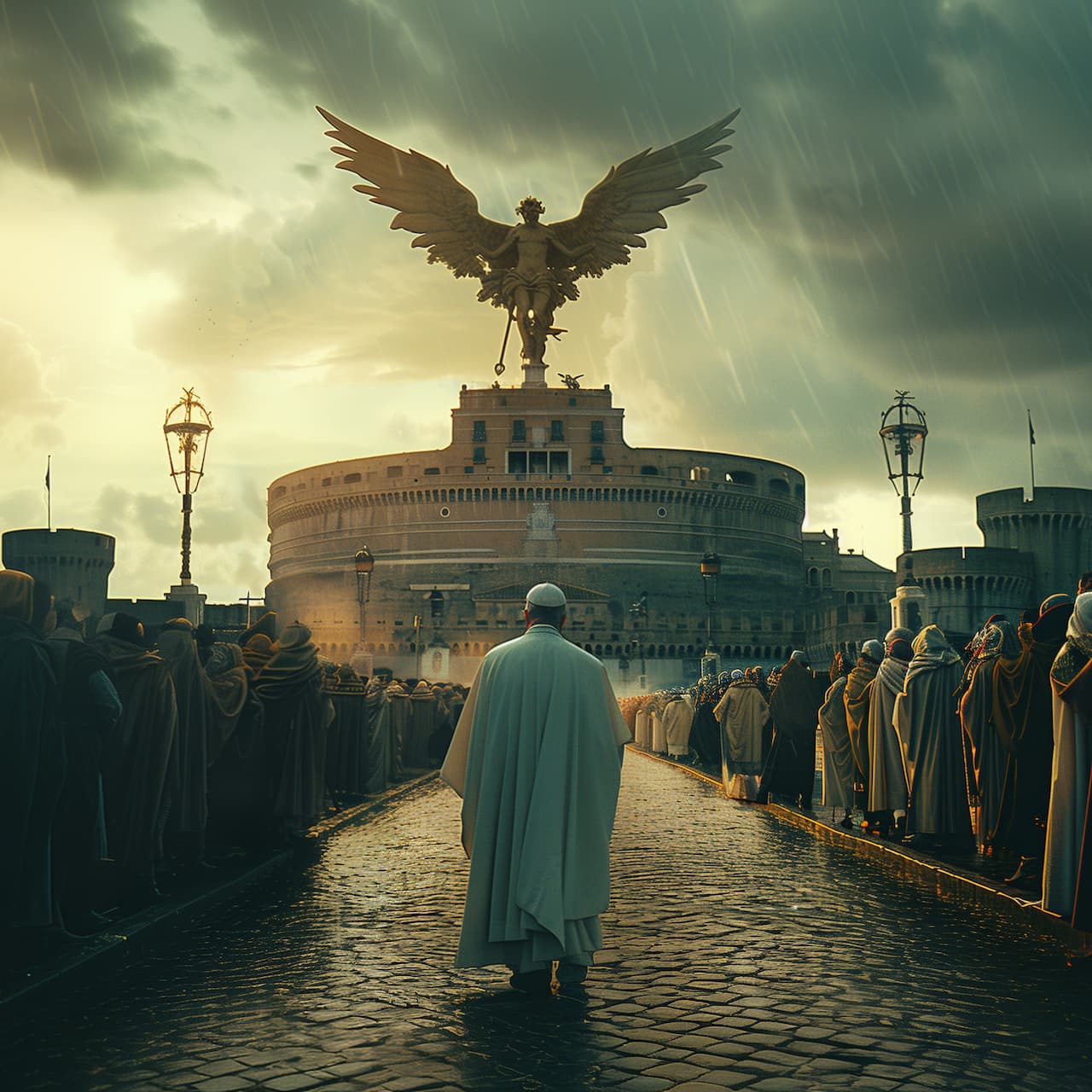
Pope Gregory the Great and the vision of the angel
You will now understand the long transition that led the Mausoleum of Hadrian to become one of the most distinctive castles on the peninsula, but I am sure you will still have a doubt: why Sant’Angelo? I have deliberately omitted a history that will certainly clarify why this name.
It is 590 AD and someone, from one side of the Tiber, pointing to a gigantic monument calls it ‘Castellum Sancti Angeli‘. But what has changed?
These are dark years, Rome has been struck by an epidemic of plague, there are rumours of an angel and a devil roaming the city. Newly installed Pope Gregory the Great calls a penitential procession and prays for the city to be delivered from the affliction.
And at the head of the procession, just as he is crossing the Ponte Elio, the pontiff has a vision: he sees before him, at the top of the Mole Adriana, the archangel Michael sheathing his sword.
For him there is no doubt, it is a divine sign. The epidemic, he announces, has its days numbered. And this proves miraculously true.
From then on, the building, formerly castellum, is designated by the name Castel Sant’Angelo. A church named after the angel is erected on its summit.
- The first statue depicting the archangel, made to commemorate the event, is constructed of wood.
- A second one in marble followed, destroyed during the uprising of 1379.
- The third one, also made of marble but with bronze wings, falls apart when a lightning bolt hits the castle and blows up a gunpowder store.
In 1497 they opted for a bronze statue, but in 1527 the need for war imposed the need to cast it to make cannons.
During the same century, another marble version was built with bronze wings, which was later replaced by the present-day bronze statue in 1753.
It was created by Flemish sculptor Peter Anton von Verschaffelt.
The Legend of the Magician Pietro Bailardo

The magician Pietro Bailardo in the cell of Castel Sant’Angelo
You know, even the best make mistakes. So it happens that a mage powerful ends up in a communal cell in Castel Sant’Angelo.
We are in the XV century, and the magician in question is Pietro Bailardo, a legendary figure in the folk tradition of Naples and Campania. The magician is said to have studied on the Libro del comando, an ancient formulary of black and white magic dating back to the time of the great poet Virgil.
There are stories about this character in Rome as well, and one of these has him left to rot with fifteen other prisoners in a common cell in the Castellum Crescentii.
The day after his arrest, after having slept a peaceful sleep protected by his fame, the powerful wizard addresses his fellow inmates: he says he is capable of casting great spells, and that he can do evade them all even on the same day.
The cronies, initially wary, decide to give him credit. Bailardo, then, approaches the wall of the cell facing outside, draws a circle in the air and, with a burnt rod, draws the shape of a boat on the wall.
He does all this while whispering magical formulas, then looks at his satisfied companions and invites them on board. One of them approaches the boat and, to his surprise, discovers that it is real. They all rush and board the magical vessel.
Upon boarding, Bailardo doubles and leaves a copy of himself in the cell. When questioned by his companions, the magician replies calmly: “I don’t want to miss the face of the jailers when they enter the cell.”
The boat sails fast on the Tiber and brings them to safety.
The Legend of the Ghost of Ponte Sant’Angelo
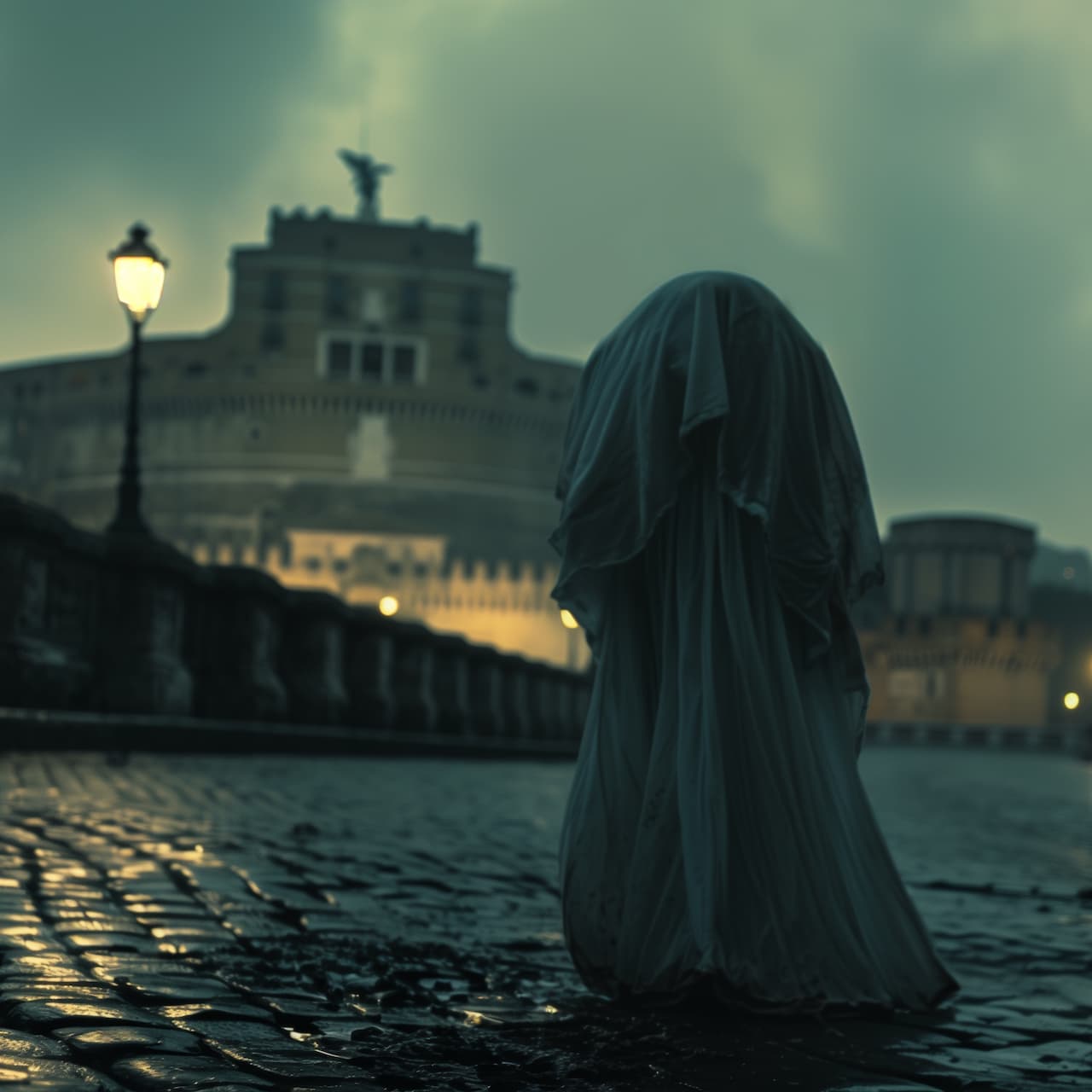
Headless Ghost by Beatrice Cenci
Although the story of the magician Pietro Bailardo is amusing, not all the legends concerning Castel Sant’Angelo will make you smile.
Indeed, it is said that a ghost inhabits Ponte Sant’Angelo, and that you can see him on the night between 10th and 11th September each year.
The ghost is that of Beatrice Cenci, a young lady who lived in late-Renaissance Rome and is the protagonist of a tristful story that sees her, as soon as she is sixteen years old, subjected to violence by her father Francesco Cenci.
Beatrice was born in Rome in 1577. The Cenci are a noble Roman family of ancient descent. Their father, Francesco, is a count rissy and violent, and has frequent problems with justice.
During the pontificate of Pope Sisto V he was forced to exile himself to the Rocca of Petrella Salto, in the mountains between Lazio and Abruzzo.
Here, infatuated with a girl from the neighbouring village of Vittiana, he has her kidnapped and, following her refusal, killed by his men.
The news did not take long to reach the ears of Marzio Catalano, lover of the maiden and chief brigand of the place, who rushes to the Rocca to obtain a vendetta; but the count, warned in time, refuses first to Naples and then back to Rome, comforted by the death of Sixtus V.
Following the death of their mother in mysterious circumstances, Beatrice and her elder sister Antonina were sent to the monastery of the S. Croce di Montecitorio as educated girls.
They stayed there for eight years, but when they returned home the situation had worsened: the three eldest sons, Giacomo, Cristoforo and Paolo, lived in indigence and, exasperated, in 1594, they sued their father and won.
In the same year, Francis was charged with sodomy and to get rid of it, he paid a disproportionate sum, further eroding the family fortune.
The sons then asked the pontiff Clement VIII to intervene, obtaining his help, and contributing to their father’s ira paterna.
After shelling out a lot of money for the dowry of his eldest daughter, Francesco enclosed Beatrice and his second wife, Lucrezia Petroni, in the fortress of Petrella Salto.
Here they gain the understanding of the servants, who are also mistreated by Francis.
Shortly afterwards, Francesco himself retires to the fortress because of health problems. Now Beatrice has no escape and is tormented by her father at every opportunity.
For her, the only way left is murder.
On the night of 9 September 1598, with the complicity of a large part of the family, the former castellan Olimpio Calvetti and Marzio Catalano hammered Francesco and threw the body over the balustrade simulating an accident. But the tyrant’s death attracts too many suspicions and the doctors’ finding is an incompatibility between the injuries and death by falling.
Two investigations are opened, one by the Viceré of Naples, the other by Marzio Colonna, owner of the fortress.
Taken to Castel Sant’Angelo, Beatrice and her stepmother witness Catalano’s tortures, but deny any involvement.
One by one, all the defendants are tortured, and all end up blaming Beatrice. Finally, she too is tortured and confesses, ending the trial.
On 11 September 1599, Beatrice Cenci was decapitated in the piazza of Castel Sant’Angelo. Legend has it that her phantom still appears every year on the night between 10 and 11 September, in the act of walking from the Ponte Sant’Angelo towards the square of the gallows, holding her head in her hands.
Castel Sant’Angelo: Curiosities
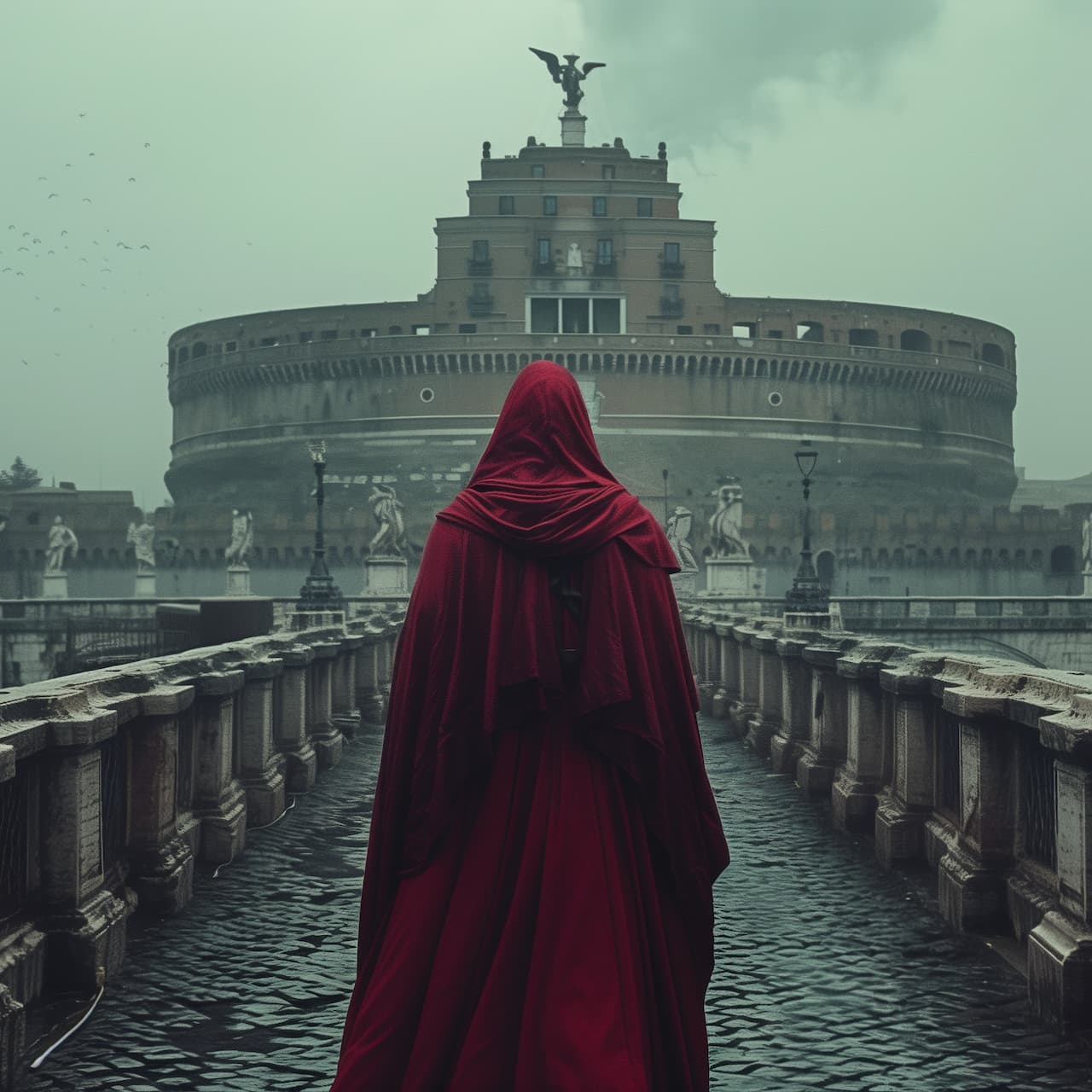
Mastro Titta, the executioner of Rome
Castel Sant’Angelo has always tickled the curiosity and fantasy of artists from every era and part of the world. I beg your pardon? Has it tickled yours too? Here, then, are a few interesting facts that will make you appreciate its history even more.
- The Statue of the Angel: The statue that gives Castel Sant’Angelo its name has not always been the same throughout its history. From the first one made of wood, then a marble one destroyed during a riot, to the present one made of bronze by Flemish sculptor Peter Anton von Verschaffelt in 1753. The statue has undergone various transformations and accidents, including being damaged by lightning in 1497 and being cast in 1527 for cannon production.
- Prisons: The Castel Sant’Angelo was used as a prison for many centuries. The cells, including the dreaded dungeon of San Marocco, were reserved for high-profile inmates. Personalities such as Benvenuto Cellini, Platina, Pomponio Leto, Beatrice Cenci and Giordano Bruno were imprisoned here. Cellini is famous for his escape during a party, using knotted sheets to lower himself from the San Giovanni bastion.
- Mastro Titta, the executioner of Rome: Giovanni Battista Bugatti, known as Mastro Titta, was one of the most famous executioners of the Papal States, with a career spanning 68 years and more than 500 executions. In addition to his macabre profession, he also ran an umbrella shop. Although he was disliked, he was a celebrity in Rome in the 19th century. His figure has fuelled numerous legends and he is still remembered today through poems, musical plays and films, as well as being associated with alleged ghostly apparitions in the city.
For more information, read my article on the curiosities of Castel Sant’Angelo Rome.

Tickets for Castel Sant’Angelo Rome: quick access.
Buy online. Choose your preferred time. Visit Rome’s Castel Sant’Angelo, the Sant’Angelo Bridge, the prisons and much more.
You can cancel free of charge up to the day before the visit
Castel Sant’Angelo Museum: Frequently Asked Questions

Tosca jumps from Castel Sant’Angelo
The Tosca, heroine of the historical drama by Victorien Sardou and of the liric opera based on Puccini, in the last act throws herself from Castel Sant’Angelo where her lover, the painter Mario Cavaradossi, has just been deceived.
In addition to the cenera of Adrian himself and his wife, Vibia Sabina, the mausoleum houses those of Antoninus Pius, his wife Annia Galeria Faustina and their children, of Lucio Aelius Caesar, of Commodus, of Marco Aurelio and three of his sons, of the emperor Settimio Severo, of his wife Giulia Domna and sons Geta and Caracalla.
The Construction of the Mole Adriana was directed by the architect Demetriano, commissioned by the Emperor Adriano, who wanted to build a funeral mausoleum for himself and his family; but over the centuries there were many architects and engineers who contributed to the building of the Castle as we know it.
Now a museum, Castel Sant’Angelo was originally a funeral mausoleum. In the Middle Ages it was converted into a military fortress, in the Modern Age it was also the Papal Residence, tribunal and prison of the Papal State.
History of Castel Sant’Angelo Rome: Conclusions
Well, we have come to the end of this long journey into the history of Castel Sant’Angelo. We talked about the short and deep history of the building, starting from its very ancient Roman roots, passing through the medieval history and arriving up to the present day.
I have told you the story of the Angel, that of the magician Pietro Bailardo, and other of the most famous legends about the castle.
I have also informed you of some of the many curiosities about the history of the building and answered some of the most frequently asked questions.
If you need more information, please leave a comment below; if you would like to visit the Castle, click here and buy your ticket and skip the ticket line.
